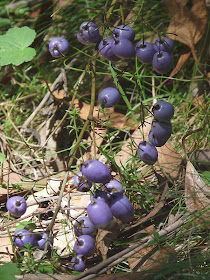This is the final instalment of my discussion and celebration of blue in nature - which in turn is part of a sporadic series on colour in the natural world. As foreshadowed, this one focuses on plants. Unlike in animals, blue pigments are quite common in plants - flavonoids, indigoids, phytocyanobilins and anthocyanins can all produce blue flowers. Anthocyanins are interesting in that they can produce red, violet or blue depending on the acidity of the cell sap - some gardeners alter soil pH to influence the colour of their hydrangeas.
However it seems that structural blues in plants may be more prevalent than hitherto recognised; this article gives an interesting overview of what is - and isn't - known about it. As far as I can determine though, this has scarcely been investigated for Australian plants.
There is another aspect that I must mention too, in that it affects my choice of photos. I have trouble sometimes deciding if a colour is blue or mauve; my partner and I differ, sometimes significantly, in how we interpret these shades. The other side of this coin is that cameras are notoriously unreliable when it comes to reproducing blues accurately, and some of the pictures below look a lot less blue to me than I recall their subjects being!
Anyway, that's enough introduction; let's just celebrate some delightful flowers.
+Pindar+0908.jpg) |
| Blue Pincushion Brunonia australis Goodeniaceae, north of Perth, Western Australia. |
 |
| Hand Flower Cheiranthera cyanea Pittosperaceae, Wee Jasper, New South Wales. The common name refers to the oddly-positioned anthers (the genus name means 'hand-anther'). |
+close-up+Lake+Monjimup+0908.jpg) |
| Narrow-leaved Squill Chamaescilla spiralis Anthericaceae, Esperance, Western Australia. A delightful lily, which can grow en masse from pure sand. |
 |
| Nodding Blue Lily Stypandra glauca Phormiaceae, Canberra. |
+Moore+River+NP+0808.jpg) |
| Blue Tinsel Lily Calectasia grandiflora Dasypogonaceae, Moore River National Park, Western Australia. One of those which looks bluer in my mind than it does in this photograph. |
 |
| Smooth Flax Lily Dianella longifolia Phormiaceae, Canberra. |
 |
| Blue Lechanaultia Lechanaultia biloba Goodeniaceae, north of Perth, Western Australia. One of the most breathtakingly blue flowers I know; quite stunning. |
And a few orchids....
 |
| Blue Fingers Cyanicula caerulea, Canberra. |
 |
| Waxlip Orchid Glossodia major, Canberra. |
+deformis+Alligator+Gorge+0807.jpg) |
| Bluebeard Pheladenia (Caladenia) deformis, Alligator Gorge, South Australia. |
 |
| Two sun orchids; Thelymitra media and T. ixioides, Ulladulla, New South Wales. |
 |
| Mountain Beard Orchid Calochilus montanus, Canberra. The shiny blue smooth plates on the labellum seem very good candidates for a structural blue, formed by layers of cells over a dark background. |
 |
| Tasman Flax Lily Dianella tasmanica, Namadgi National Park. It seems that blue berries get their colour from a waxy layer scattering blue light. |
Lastly, the article I mentioned in the second paragraph discusses some blue foliage at some length, though its purpose is not at all clear.
A very silly song that I recall expresses the hope that "these pretty flowers chase the blues away". It's too corny and inappropriate to mention here so I won't...
BACK ON WEDNESDAY





No comments:
Post a Comment